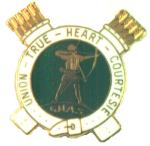When I teach people to knit or crochet, I frequently see that they think it is their hands that force the stitches into the right shape. These people tend to hold the yarn really tightly and tug on it after each stitch, thinking they are knotting the yarn into a fabric.. They are also terrified that if they lose their grip on the yarn, the whole thing will fall apart immediately.
To them I often say, "Trust the yarn. Trust the needles." The yarn has its own qualities that will make the stitches well defined, that will keep them from coming apart. The needles create the size of the stitch under regular tension, and pulling the yarn tight only fights that and distorts it.
Last night I took up a couple of pieces of knitting that were supposed to go together. This cardigan is knit from the right front edge all the way around to the left front edge -- sideways, as if you were slowly knitting a wrapping for the torso. Then the collar is knit at the end and sewn on. You can see in the photos that it is narrow at the buttoned front edges and flares out wide at the back. Like the cardigan itself, it's knitted from one end to the other, starting narrow, getting wide, then going back to narrow.
The collar has given almost the 100 or so people who've knit this sweater (and posted projects on Ravelry) fits. Instructions in the magazine were incorrect; errata were posted by the designer on Ravelry. But knitter after knitter betrayed in their notes that they didn't trust those corrected instructions. They fudged, frogged, reknit, and in many cases decided to live with a collar that wasn't perfect because they were tired of trying to make it work.
I read over those notes carefully. One of the designer's notes and a prominent knitter's notes indicated that the number of rows knit for the collar should be the same as the number of rows along the neck edge of the sweater. That made sense since the were knitted in the same direction -- sideways. If the pieces were attached with mattress stitch, row by row, they should match up perfectly. So I counted my neck edge rows -- and recounted them. Then I began the collar according to the revised instructions. All seemed well until I got almost halfway to my total row count and realized that I wasn't going to have enough rows to complete the instructions for the first half of the collar. I was going to have to start the mirror-image second half without getting to the end of the instructions that were supposed to take me to the middle.
I stopped and thought. Then I decided to trust the row count and the logic of knitting the same number of rows. I began the mirror-image decreases at the middle even though I hadn't gotten to the end of the increases. I knit to the end and completed the correct number of rows. Then I laid out the collar on top of the sweater where it was to be attached.
Way, way too small. Not even close. When I tried to stretch the collar to match the length of the neckline, it seemed impossible. I'd estimate that the collar was less than 2/3 the length of the edge to which it was supposed to be attached.
But the logic was still unassailable. The same number of rows, sewn together matched one to one, should come out perfectly. The collar, in garter stitch, was a different row gauge (number of rows per inch) than the neckline, but it was the same yarn and an only slightly smaller needle. It should work. I decided to trust the yarn, trust the numbers, trust the logic of the one-to-one seam, and start sewing, regardless of the apparent disparity.
And it worked. Row by row I sewed, and as I approached each clip I had used to pin the two pieces together and keep the ends and middle lined up, the gap between the two pieces straightened, evened, and disappear. The lower edge of the garter-stitch collar stretched, row to row, while the top edge stayed prettily compact. By the time I reached the middle of the seam, I was elated; what had seemed impossible was turning out better than almost all of the projects whose notes I perused, by knitters who had tried to make it work this way and that because the instructions and result as given seemed so problematic.
Trust the yarn. Trust the needles. And trust the numbers. If you can let go of your worries and your tendencies to fix or shore up your work before you see the outcome clearly, you will frequently experience that elation as the impossible becomes the elegantly real.
Subscribe to:
Post Comments (Atom)





No comments:
Post a Comment